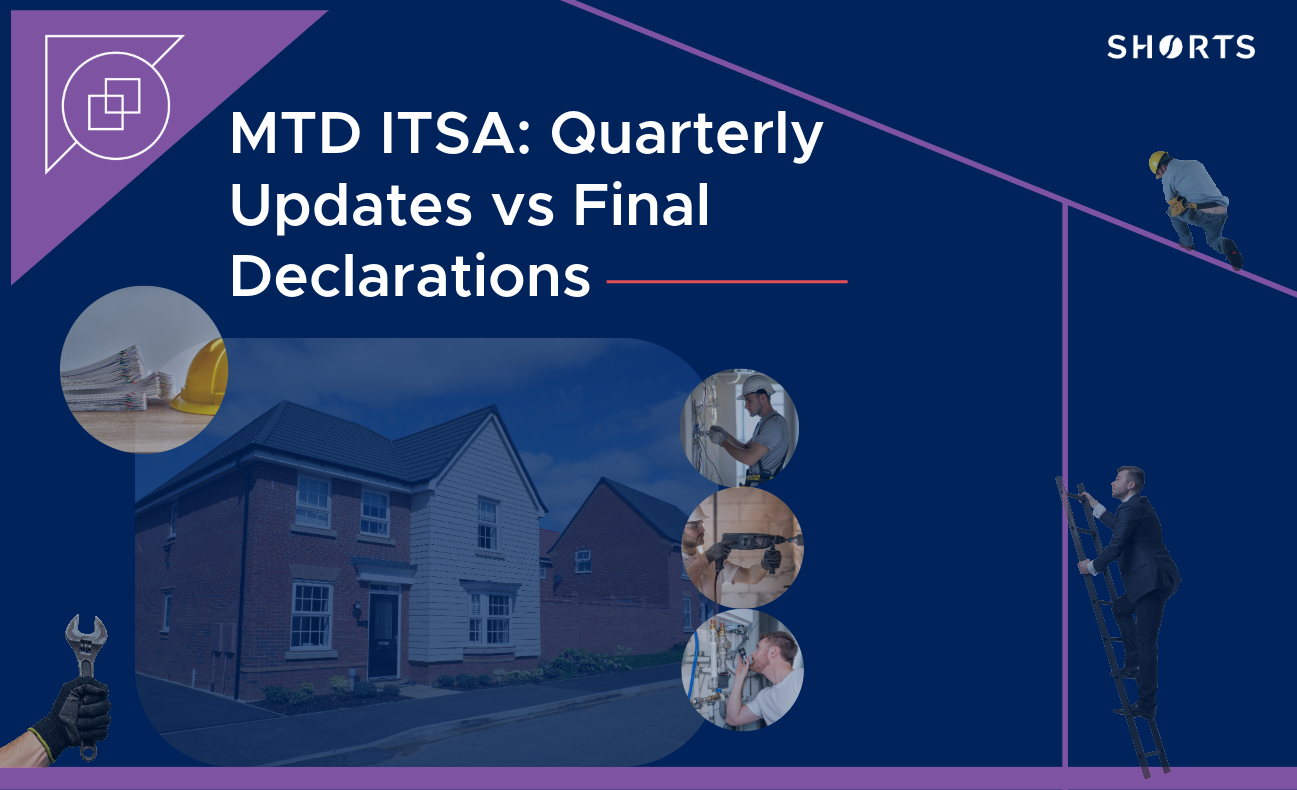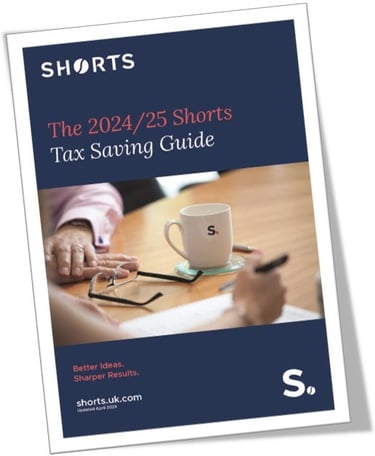
The UK tax system is undergoing a significant transformation with the phased rollout of Making Tax Digital for Income Tax Self-Assessment (MTD for ITSA). Designed to digitalise tax reporting and reduce the risk of errors, MTD will change how sole traders and property landlords manage their tax affairs.
The first mandatory phase is approaching. It’s essential to understand the filing requirements, in particular the difference between quarterly updates and the final declaration.
What is a quarterly update?
For those mandated under MTD for ITSA, the traditional annual self-assessment tax return will be replaced by the following:
1. Digital record-keeping
Taxpayers must maintain digital records of income and expenses using HMRC-recognised software. HMRC does not provide free software but offers a list of approved providers.
2. Quarterly updates
Every quarter, a summary of income and expenses must be submitted to HMRC.
3. Final declaration
A final declaration must be submitted to include all additional income sources, adjustments, and reliefs. This replaces the current Self-Assessment tax return.
Quarterly updates for MTD for Income Tax: the essentials
Quarterly updates are mandatory for sole traders and landlords with a gross income over £50,000 from April 2026. The threshold is based on a combined gross income (before expenses) from self-employment and property.
1. Self-employment income: Includes all gross income from sole trader activities, freelancing, consultancy, etc.
2. Property income: If you own property jointly, HMRC assesses your share of the gross income.
Summary table: qualifying income examples
|
Scenario |
Self-Employment Income |
Property Income |
Total Qualifying Income |
MTD Status |
|
Sole trader only |
£60,000 |
£0 |
£60,000 |
MTD from April 2026 |
|
Landlord only |
£0 |
£55,000 |
£55,000 |
MTD from April 2026 |
|
Mixed income |
£27,000 |
£25,000 |
£52,000 |
MTD from April 2026 |
|
Joint property (50%) |
£0 |
£15,000 |
£15,000 |
Below threshold |
The requirement applies per individual, not per business or property.
Each individual owner of a jointly held property must assess their own qualifying income to determine if they fall within the scope of MTD.
HMRC uses the Self-Assessment tax return from the previous tax year to determine your qualifying income. For example, to assess MTD eligibility for 2026–27, HMRC will review your 2024–25 tax return, due by 31 January 2026.
What information should the quarterly updates include?
Quarterly updates are summaries, not full tax returns, and do not include tax reliefs or adjustments at this stage. They must include:
-
Income totals for the period (e.g., sales, rental income).
-
Expense totals, according to HMRC’s prescribed categories (e.g., travel, repairs, insurance).
-
If your total income is below £90,000, you can categorise each item simply as ‘income’ or ‘expense’, rather than using detailed categories.
- If you have multiple income sources (e.g., self-employment and rental), you must submit separate quarterly updates for each source. For instance, if you are a self-employed plumber and you also let a UK property, you will need to submit two returns each quarter.
-
If you own property both in the UK and overseas, you must maintain separate records and submit separate quarterly updates for each property business.
Updates are cumulative, meaning:
-
Corrections to previous submissions can be made in the next update.
-
You do not need to resend the original update after making a correction.
Joint property owners must submit separate quarterly updates to HMRC. However, HMRC has introduced two easements to simplify reporting:
-
You can submit one total income figure per quarter across all categories.
-
Expenses can be reported once annually in the final declaration.
What’s the process for submitting a quarterly update for MTD for Income Tax?
Quarterly updates must be submitted to HMRC via MTD-compatible software. The process typically involves:
-
Digital record-keeping throughout the quarter.
-
The software aggregates totals for income and expenses.
-
You (or your accountant) review and electronically submit the update to HMRC.
You can authorise an agent or accountant to submit updates on your behalf.
Each quarter, HMRC receives summarised totals of income and expenses from your digital records. This helps HMRC:
-
Track compliance with MTD obligations
-
Identify discrepancies or anomalies early
-
Encourage regular record-keeping, reducing year-end errors
After each quarterly update, HMRC:
-
Uses the submitted data to generate an estimated tax bill
-
Displays this estimate in your HMRC online account or within your software
This helps taxpayers:
-
Plan for future payments
-
Avoid surprises at year-end
-
Adjust business decisions based on projected liabilities
If no income or expenses occurred during a quarter, you must still submit a nil return to HMRC.
When will you need to send quarterly updates for MTD for IT?
Each update covers a three-month period, with submission due one month after the period ends:
|
Quarter |
Period Covered |
Deadline |
|
Q1 |
6 April – 5 July |
7 August |
|
Q2 |
6 July – 5 October |
7 November |
|
Q3 |
6 October – 5 January |
7 February |
|
Q4 |
6 January – 5 April |
7 May |
Alternatively, you can elect to use calendar quarters (e.g., April–June, July–September) for simplicity.
HMRC is introducing a points-based penalty system:
-
1 point per missed submission.
-
Quarterly filers incur a £200 fine after 4 points.
-
Points expire after 2 years, but only if you file on time for 12 months.
What is a final declaration?
The Final Declaration is the digital replacement for the traditional Self-Assessment tax return (SA100). It’s the final step in the MTD reporting cycle, submitted after the end of the tax year, and it confirms your complete tax position for that year.
The MTD for Income Tax final declaration process
The Final Declaration consolidates all relevant financial data for the tax year, including:
1. Quarterly Update Data
- The quarterly updates feed into the final declaration pre-populating income and expenses from self-employment and property businesses
2. End-of-Period Statement (EOPS)
- Adjustments for tax reliefs, allowances, and accounting corrections.
- Claims for Capital allowances (e.g. for equipment or vehicles).
3. Combining with other income HMRC already holds (e.g. PAYE, pensions) and add any other income sources
-
Employment income (PAYE)
-
Dividends
-
Interest from savings
-
Pension income
-
Foreign income
4. Additional Information
- Any other relevant disclosures required to calculate your final tax liability.
Submitting your declaration
You must use HMRC-recognised MTD-compatible software to:
-
Maintain digital records
-
Submit quarterly updates
-
Complete the EOPS
-
Submit the Final Declaration
When will the final declaration process be introduced?
The Final Declaration will be due for submission by 31 January following the end of the tax year. The first relevant tax year will be 2026–27, and the Final Declaration must be submitted by 31 January 2028. This replaces the Self-Assessment tax return.
What you need to prepare
You cannot submit the Final Declaration until:
-
All four quarterly updates have been submitted.
-
The EOPS is completed.
-
All other income sources are reported (e.g., employment, dividends, pensions)
-
Adjustments and reliefs have been claimed
Unlike quarterly updates, the final declaration:
-
Requires client approval
-
Triggers HMRC’s real-time tax calculation
-
Finalises your tax position for the year
What happens after you submit your declaration
HMRC uses the Final Declaration to calculate your final tax liability for the year. Once submitted, HMRC will issue a final tax calculation, which includes:
-
Balancing payments
-
Payments on account (if applicable)
-
Any penalties or interest due
Failure to submit the Final Declaration by the deadline may result in:
-
Late filing penalties under the MTD points-based system.
-
Late payment penalties if tax is not paid on time.
-
Interest charges from the due date.
How do the two reporting requirements differ?
|
Feature |
Quarterly Update |
Final declaration |
|
Frequency |
Four times per year |
Once per year |
|
Content |
Summary of income and expenses (each source of self-employment and or combined income from rental properties will require a separate submission) |
Full tax position including all taxable income and adjustments/claims for reliefs |
|
Tax Calculation |
No – estimates only |
Yes – final tax position calculated |
Make a start on your MTD reports
MTD introduces a new way of managing tax, and while it may feel like a significant shift, it also presents a valuable opportunity for clients to gain greater insight into their business performance.
MTD reporting requires more frequent engagement with your financial data. Rather than waiting until year-end, you’ll be reviewing your income and expenses quarterly, which can help you:
-
Spot trends and issues earlier
-
Improve cash flow forecasting
-
Make more informed business decisions
This shift from reactive to proactive tax management can be a real advantage—especially for growing businesses.
Get ready for MTD ITSA
At Shorts, we understand that adapting to MTD can be daunting. That’s why our team is here to:
-
Help you choose and set up MTD-compatible software
-
Ensure your digital records are accurate and compliant
-
Submit your quarterly updates, End-of-Period Statements, and Final Declarations
-
Provide ongoing support and advice tailored to your business
Whether you’re a sole trader, landlord, or managing multiple income streams, we’ll guide you through every step of the process. If you’re unsure where to begin or want to make sure you’re on the right track, don’t hesitate to reach out to Shorts.

Steven Strawther
I deal with all aspects of personal tax compliance and since joining Shorts I have gained valuable experience in private client advisory and planning opportunities. I have been instrumental in refining the personal tax compliance process and implementing digital solutions to provide clients with an efficient personal tax service.
View my articlesTags: MTD ITSA


